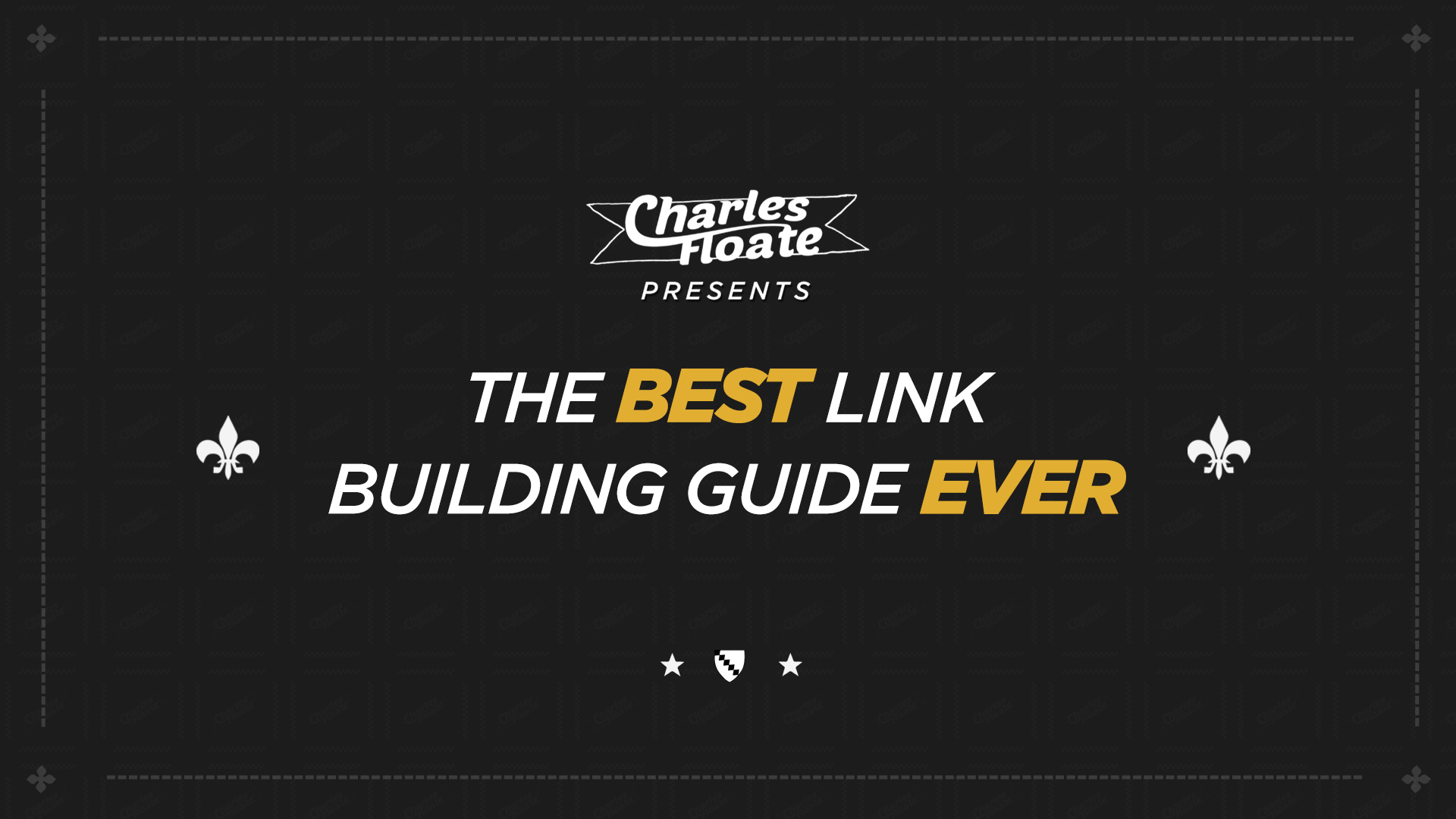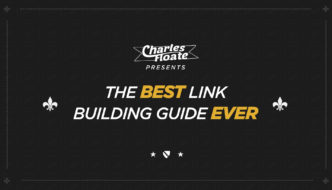11/04/2017 Update: As we’re now in 2017, I thought I’d change this from the best link building guide in 2016.. To the best link building guide, EVER. I’ve added several new techniques, updated information based on new findings and most importantly changed the featured image & name to match this newest version – Which is over 17,000 words long… I wrote a dissertation on link building, and didn’t even finish high school let alone university!
21/09/2016 Update: I decided, considering this is one of my most popular posts on my blog, and that I could update this even more.. I would go ahead and do so.
Since launching my agency, I’ve been almost forced into looking for even more techniques, tips and tricks to acquire links than ever before. In the first sentence of this post, I said that the post is an attempt at completely covering link building tactics, but this post was FAR from complete. So this update will give you a lot more complete version, that I wanted to achieve in the first place.
This post is an attempt at completely covering link building methods & techniques that actually work, and will continue to work in the future – This post has taken me about 70+ hours to put together, and will likely take you a while to go through as well, so make sure you have some time to dedicate or you’ll probably miss a couple gems. I hope you enjoy it.
Before we get into the techniques themselves, I wanted to make sure all of you guys and gals understand that I am going to be covering a number of techniques, some white, some grey, some black… You may not agree, approve or like some of them, but at the end of the day: They work and I’ve successfully used every single one of them in multiple scenarios and campaigns to rank a number of different websites and properties.
P.S. In the UK, we spell “gray” as “grey” – Hence why I’ve put it with both spellings, as to not annoy Americans or the Brits.
SEO in 2017
I recently made a pretty large presentation on my overall thoughts on SEO in 2017, so before we get into link building you can check out my overall thoughts on the current state of SEO here –
Hopefully this video should give you a complete overview of where I think SEO is going this year (and beyond), and it’s a great way to lead into all of my link building techniques & methods.
Note: I did an accompanying blog post for last years presentation, in which I made a 187 word SEO Glossary, if you’re fairly new to SEO it may be a good idea to have that blog post open in a different tab, so you understand everything inside this blog post – As some of the wording I use can be rather technical.
These techniques are in no particular order, I’ve just compiled some of my favorite methods I’ve been using this year so far, that have given me the most success on this site and my many other properties as well.
Table of Contents
Master Content (White Hat)

Some of you may know this as the Skyscraper technique, some of you may know it as some other variation of “content marketing” but at the end of the day, it’s all link-bait and I like to make sure my link bait is worth linking to.
The idea behind it is you make a complete resource to cover a specific area/problem people may have.
A great example of this kind of link building method is Neil Patel’s QuickSprout guides:
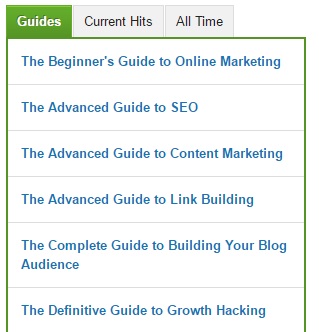
He makes massive guides that mostly target beginners in the internet marketing niche and help them learn the basics (and sometimes beyond) of a specific part of the industry.
Let’s take his “Advanced Guide to SEO” as a perfect example, it’s a custom designed (and developed) complete introduction to Advanced SEO, it’s 9 chapters and nice design have made it almost like an eBook inside a website. This has also led to this specific guide (according to Majestic) getting links from over 660 referring domains, including sites like Entrepreneur.com, TechCrunch and The Next Web –
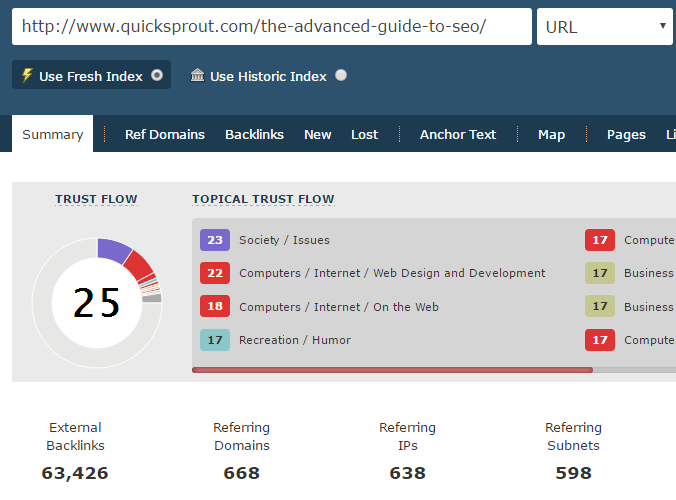
What I am definitely not saying is you have to go and create a post the length of a book with custom developed graphics and design to get these kinds of results. Though generally the longer the post, the more likely you are to have a large amount of links and social shares – Which all contribute to your site becoming an “authority” within the eyes of Google.
So, let’s get into creating your link bait content.
Step 1) The Concept
The best way I find ideas to create these kinds of pieces of content is using the website Reddit. Reddit is a community news site that has similar functionality to a forum, it has individual “subreddits” which act as the sections of the site, each subreddit focusing on a different topic.
In this example, we’ll be using SEO as the example and using the most active SEO subreddit, /r/bigseo.
Each subreddit has a number of different lists, such as “hot” “new” “controversial” and “top”, as well as a few others… To do what we want to achieve, we’ll be using the “top” list, which lists the best submissions of all time –

I just look through the top posts for a correlation, in this instance I find a few correlations:
- Local SEO Case Studies are popular
- Google Updates are popular
- Link Networks & Backlinks as a whole are popular
It’s fairly easy to take these correlations of popular topics and turn them into headlines, which can then be turned into link bait content pieces, here’s some examples that I came up with from these top posts:
- An On-Going History of Google Algorithm Updates
- Evaluating 100 Local SERPs
- Buying Links From The Dodgiest Link Network on Earth [A Live Case Study]
All of these headlines can easily be turned into MASSIVE pieces of content, it just requires time to research, write and design them.
Step 2) Creating Your Content
This is going to be the most difficult part of this entire procedure, some people love writing, some people cannot stand it.
You don’t need to be a graphic designer or know CSS to be able to create a fantastic piece of content. A great example of this would be Krill Oil’s Nutrition Pyramid, which is 36,000 words formatted using free WordPress plugins and using charts made in PowerPoint – All very simple tasks, aside from the writing 36k words bit.
This blog post has since received links from over 75 referring domains (according to Majestic) and many of them hold a lot of weight in the health niche.
Again, these are all examples but you want to be aiming for a minimum word count of 2,300 normally – Things like infographics and videos (both of which you can outsource) can massively increase the value of your piece, and increase the likely of you getting linked to.
Step 3) Gaining Links
The obvious, first thing you should do is submit the piece to the subreddit you get your idea from – See how it performs, get feedback and make any necessary edits from the feedback you receive. Just note that self promotion doesn’t go down to well on Reddit, so try and interact with the community and get a bit known in that subreddit before smashing links to your new, gigantic piece on algo updates.
There are also several other ways to go about building links to your new piece, and here’s a few ideas for you to use:
- Use similar content pieces to find people linking to that kind of content (and then outreach).
- Use social media (I normally go with Twitter) to reach out to influencers/bloggers about your new piece.
- Outreach via email (BuzzSumo & NinjaOutreach are 2 good tools for this) to influencers/bloggers about your new piece.
- Outreach to website owners with niche related “Links Pages” and showcase your piece of content, you can see a live example of this for the Krill Oil post here – http://www.therubins.com/aging/sites.htm
I’ve also used paid traffic like Facebook Ads and Outbrain to find people that’d enjoy your piece of content.
A good example of this would be using Facebook Ads to target the piece at people with “blogger” “writer” etc… in their job name, and then putting your industry into the interests section. I’ve done this before to great success, spending under $100 on a campaign and acquiring over 15, solid links.
Private Blog Networks (Black Hat)

Private blog networks (or “PBNs”) are currently, and have been the most used and effective way to rank sites for the last few years, they’re constantly talked about and it’s gotten so big that an entire sub-industry has been setup around them.
I’ve already wrote an extensive guide on how to build your own PBN, so I’m not going to be re-covering what I’ve already said inside there. However, I am going to give you a bit of a background to this new PBN industry, how you can get top quality links at decent prices from vendors I personally use and I’ll start with why PBN links are such a good idea and why they are so effective.
The Rise of the Private Blog Network
Unlike directories, guest posts, comments and various other types of links… If you run your own PBN and use it for ranking your websites then you have full control over the links pointed at your site – If a link gets deindexed, you can remove it, if you want to change the anchor text linking to your site, you can and so on… It’s this kind of complete control that attracts so many people to build their own PBN.
Not only does it allow you to have complete control over your link profiles, but it’s also fairly inexpensive to go out and build your network. Here’s a quick breakdown of what it’d likely cost you to build a 10 site niche relevant network, that can be used to rank most moderate keywords:
$30 per domain name ($300 – for 10)
$29 per month for hosting 10 sites (Using Easy Blog Networks)
$300 for 10 x 1,000 word content pieces
That totals $948 to create a completely niche relevant network and host it for an entire year.
That works out very inexpensive when you think you can use it to rank a website that makes hundreds, if not thousands of dollars per MONTH. Giving you an extremely high profit margin at the end of it.
If you use free (or cheap) tools to scrape your own domains as well, then you can cut out all or at least some of that $300 fee for domains.
PBNs have become such a widely used tactic, even white hat SEOs are admitting they actually rank and Google can do a very limited amount of things about them.
Google’s been going after popular PBN services as that’s their best fear tactic… If they can deindex a lot of people’s sits who have used PBN services then they can twist the truth and say that PBNs aren’t safe tactic to use, when in reality, buying PBN links off publicly available forums (which kind of takes the whole “private” part out of private blog networks) isn’t the safe tactic – And who know that, right?
The PBN Industry
Since PBNs have become mainstream, it seems everyone and their dog has been at it building networks, trading links and setting up their very own PBN link service… The majority of which are rather poor quality and will likely hurt your site more than help it.
In the long run, if you’re wanting to spend a lot of time ranking sites (or even just 1 main site) then it’s definitely worth it to build your own network, but if you’re just starting out and have limited time, money or simply don’t want to both with that kind of stuff then you’re best off just purchasing links – Though as I said earlier, you have to make sure you’re going with the right folks.
Luckily, there are a few services out there that are pretty decent.
Getting GOOD PBN Links At Good Prices
I’ve personally used every single one of these services, so I know they’re good and I’ve used them for several months (if not years) with consistent quality – Nothings worse than getting some epic links on your first order and getting a load of sh*t on the next.
- Freedom Links – Monthly rentals on hugely powerful sites. Ever domain is an aged, auction domain so you know you’re getting the full power with every purchase.
- Todd Foster & Niche Relevant – Please bear in mind that Todd doesn’t have a website as such to order from, so you’ll have to hit him up (or one of his staff) directly.
- Diggity Links – Now closed to new customers, but join his waiting list (which a LOT of people are on) and you should be able to eventually get some good links.
- Rank.Network – Nick Eubank’s private publishing network, small amount of sites and the prices are rather expensive but the links are a lot higher quality than pretty much any other service on the market right now when it comes to PBNs.
- Relentless Network – The cheap and cheerful alternative, if you have a small site, budget or want to go after smaller keywords then I suggest using this network. Content isn’t great, domains are decent but you can’t really complain when it comes to the under $10/link price.
I’m sure there are a lot of other fantastic services out there, but I only recommend services that I have thoroughly tested and used myself. If you have a service you use, drop it in the comments… I have upvoting capabilities in the comments section for a reason.
Note: I did a webinar with Patrick from SERPChampion in which I showcase a live example of a site I’ve built up using mostly PBNs, the site makes hundreds of dollars a month in the off-season and thousands during peak season – I recommend you have a watch if you’re interested in seeing a live example of a profitable site.
Blog Commenting (Grey/Gray Hat)

This method has probably been my most used backlinking technique ever, in my 8 years of doing SEO I’ve posted a ridiculous number of blog comments, using ScrapeBox comment spam back in 2008 to building extremely detailed comments for links today.
The mass, spammy ways of building blog comments are a thing of the past for me at least. I know several people have still been having success using spam comments, but I have been purely doing a more white hat way of building comments, commenting on posts in my target industry/niche that I have actually read through and with comments that are not only extremely lengthy, but have a 100% approval rate.
As an example, I did a comment on Nick Eubank’s (An SEO I recommend you follow) SEOAuv blog post covering Moz’s domain authority metric, my comment looked like this –

Note: You can see this comment live here.
These kinds of comments are the ones you should be aiming to build on a regular basis. A comment of this depth and size takes around 15 minutes to craft, so you could easily build 10 – 20 comment links every day, and even though they’re NoFollow they aren’t a complete waste of time.
Not only do these links help your NoFollow/DoFollow ratio, but they also help with your anchor text ratios – As you’ll be using brand names and personas as the anchor text in your comments.
Comment links can also offer a very large trust signal which can have a direct impact on your rankings.
Step 1) Prospecting For Comment Opportunities
There are several ways for you to find good posts to comment on, the best of them is using Google itself – Unless your industry has a platform like Inbound or Hacker News, which is unlikely, it’s best to go with Google.
All you have to do to find posts to comment on, is use some pretty simple Google “operators” aka “footprints” which allow you to search Google for very specific criteria, in our case we’ll be using SEO as a good example and going after sites that run on WordPress and run their default (or a variation of it) commenting system.
A very basic example of this would be using the following operator –
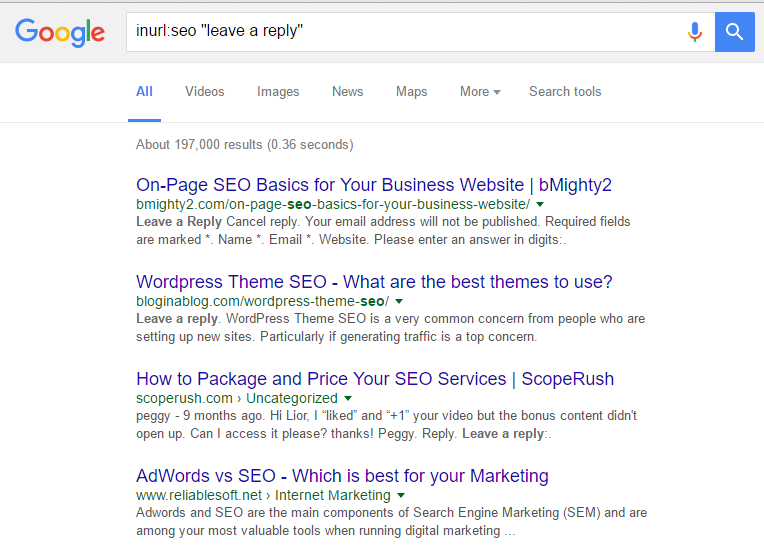
You can also use a variation of other Google operators to find good posts to comment on, here’s a few examples:
- inurl:SEO “your email address will not be published”
- inurl:SEO “add new comment”
Make sure to change out the SEO part of it for your niche or keywords.
If you want to comment on posts that are recent, then simply do your operator and click on “Search Tools” then change the “Any Time” drop down to a specified amount of time, like so:
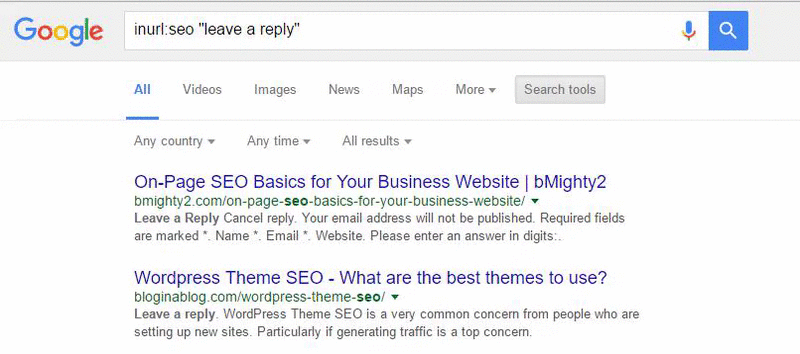
You can select by past 24 hours, week, month or year – I normally use the month or year options as the other options are a bit too soon for my liking and don’t really allow time for a post to gain links or value.
I manually look at a post, scroll down to the comments section and normally go with posts that already have at least 3 comments on them. If a post doesn’t have any comments on it, then it’s likely not going to have much value.
Note: Systems like Disqus, LiveFyre etc… Don’t allow you to get a link back to your website, so make sure you’re using a comment system that has a website input field or it’s not a backlink technique.
Step 2) Crafting Your Comment
A comment is a reply to the post, as such you should make your comment a proper reply… I always imagine I am writing a letter to the person who wrote the post.
Maybe you disagree with some points in the post, maybe the post showed you a new way/tool/service that you’d never seen before, or you can always just go with the ego-bait style and say you completely agree with them and then list the points that you agree on.
Realistically, you want a comment that’ll get the author to reply to you. This means you have a lot higher chance of getting your comment approved.
Step 3) Waiting
Now that you’ve posted your comment, it’s just a simple waiting game for it to be approved.
Every comment I write I put into an Excel document that looks something like this:

This makes it really easy to check back if a comment / post is still live and making sure you have data on your link building campaigns is always an added bonus.
Guest Posting (Grey/Gray Hat)

This is quite literally the most used link building tactic in the world… It become so heavily used that Google even decided to go after the white hats who were using it, and started randomly penalizing anyone associated with it, including one of the most famous SEOs in the world Ann Smarty.
Personally, there’s 2 ways I use guest posting for link building and I haven’t really talked about either (much) before. Let’s start with the most obvious, which is guest posting on other people’s websites to get a link.
Direct Link Building With Guest Posting
If you’re reading this post then I’m sure you will of seen a thousand other blog posts from 2012 and 2013 on using guest posting to build links, it was one of the hottest topics going back then, until Google came and wrecked the white hats fun and Cutts said it was “against the Google guidelines” – As if writing a post on someone else’s blog is somehow manipulating the guidelines? I’m pretty sure creating content for another website has been around before Google even existed, let alone their all encompassing, feared guidelines that will make even the most hardcore black hat shake in his boots… Can you smell the sarcasm yet?
Like the next section (on broken link building) I’m not going to write out another ridiculous piece of content on something that has already been covered so many times before.
Here’s a few well put together resources that cover guest posting in detail:
- Backlinko’s Guest Posting Guide – Probably the best known solo SEO blog, and he got there with a LOT of guest posts.
- Ryan Stewart’s Guest Posting on Scale Video Series – A great video series from the guy that came out of nowhere with guest posting on every SEO blog and site going. His process is really sound as well.
On top of showing you how to do guest posting, I recently asked my Facebook group what they thought was the best guest posting service and I have since tested a few of them myself. So I thought I’d compile a small list of service providers that offer genuinely good guest posts, not just PBNs in disguise:
- LoveTo.Link – Voted the #1 service (by you guys) in 2017, Dan Parker runs an incredibly efficent operation with access to over 350 different, real sites at extremely competitive prices (starting at just $39/Link) and very quick turn around times.
- GoodLinks.io – These guys offer a monthly link building service for the more corporate/agency clientele at $1,000/month. So if you’re doing affiliate sites or local SEO campaigns probably not the best idea, if you’re doing larger scale or corporate stuff then it’s perfect.
- Gareth Simpson – Freelance SEO from the UK, offers guest posts in tons of niches starting at about $100/link with rather quick turn around time. He’s got a ton of authority personas he’s built up over the years and is rather creative with his link placement.
- Niche Site Project’s Guest Posting Service – Big wait-list for this service, and with very good reason. The guest posts are actually white hat, targeted outreach and placed on blog’s where you’ll actually get comments, social shares and possibly links all naturally. Tad on the expensive side, but you can see why.
Note: Some of these service providers are freelancers, and as such have a limited customer base. You may not be able to get them whenever you want and may have to be added to some sort of wait-list/queue before you can order a project off them.
Guest posting is still powerful, and despite what Google has said, they aren’t going to penalize you for dropping a post on someone else’s blog. Just be careful with creating 100x 500 word guest posts on questionable looking blogs.
Having Other People Guest Post For Links
Personally, the best way I like to utilize guest posting isn’t by getting your posts on someone else’s site, it’s by getting someone else to post on your site. Something that Ryan Deiss (someone I recommend you follow by the way) was talking about all the way back in 2014, why spend hours (if not tens of hours) wasting your time creating a large piece of content for someone else’s site just so they can get a bunch of links, when you can get other people to do that for you?
I have a fantastic example of this, I spent 2 weeks working on one of the biggest posts I’ve ever written and it got guest posted on Matt Woodward’s blog, and the links it received speaks for itself –
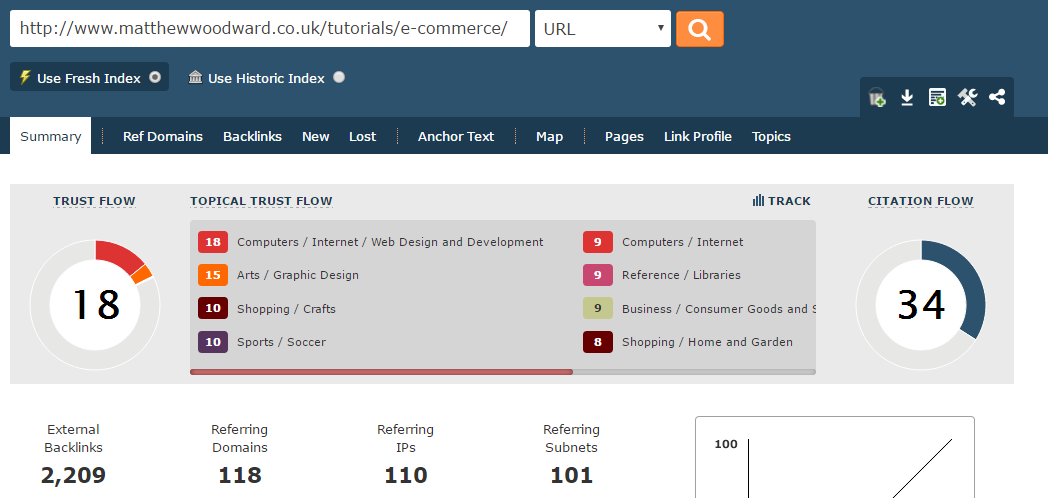
It’s since been one of Matt’s most read pieces, has a ton of social shares, over 280 comments and has generated me about 1/10th of the traffic (and NONE of the links) it generated Matt’s blog.
Now, do I regret posting it on there? Hell no, I managed to secure a £4,500/mo client off that post just 6 weeks after launching my agency, had over 600 people signup to my newsletter from the traffic the post has sent me and lead to me becoming a lot more well known across the IM and SEO world.
All of which would of never happened if I’d put it on my own blog.
HOWEVER, that was one very rare example in which his blog was the exact kind of audience my blog needed, and my blog wasn’t even 6 months old at the time I was writing it… I’d also just quit my 9 – 5 job and needed as much income to kick things off with as possible – My post was also the first ever guest post on Matt’s blog, which I’m betting he can thank me for considering he rarely posts himself now-a-days #shotsfired.
Unless you can put it on a highly targeted site that you know will give you a lot better return than posting it on your own site, that piece should be saved for the Master Content method I talked about earlier.
This piece of content is also a perfect example of why you should not only accept guest posts, but try your damn hardest to get them on your site – That doesn’t mean accepting every email you get from people wanting to write a post for you, but it does mean setting up some kind of system where you can get people who’re generally interested in expanding their own audience/fame in return for writing a piece on your site, you want people who want an audience, not a link.
Broken Link Building (White Hat)
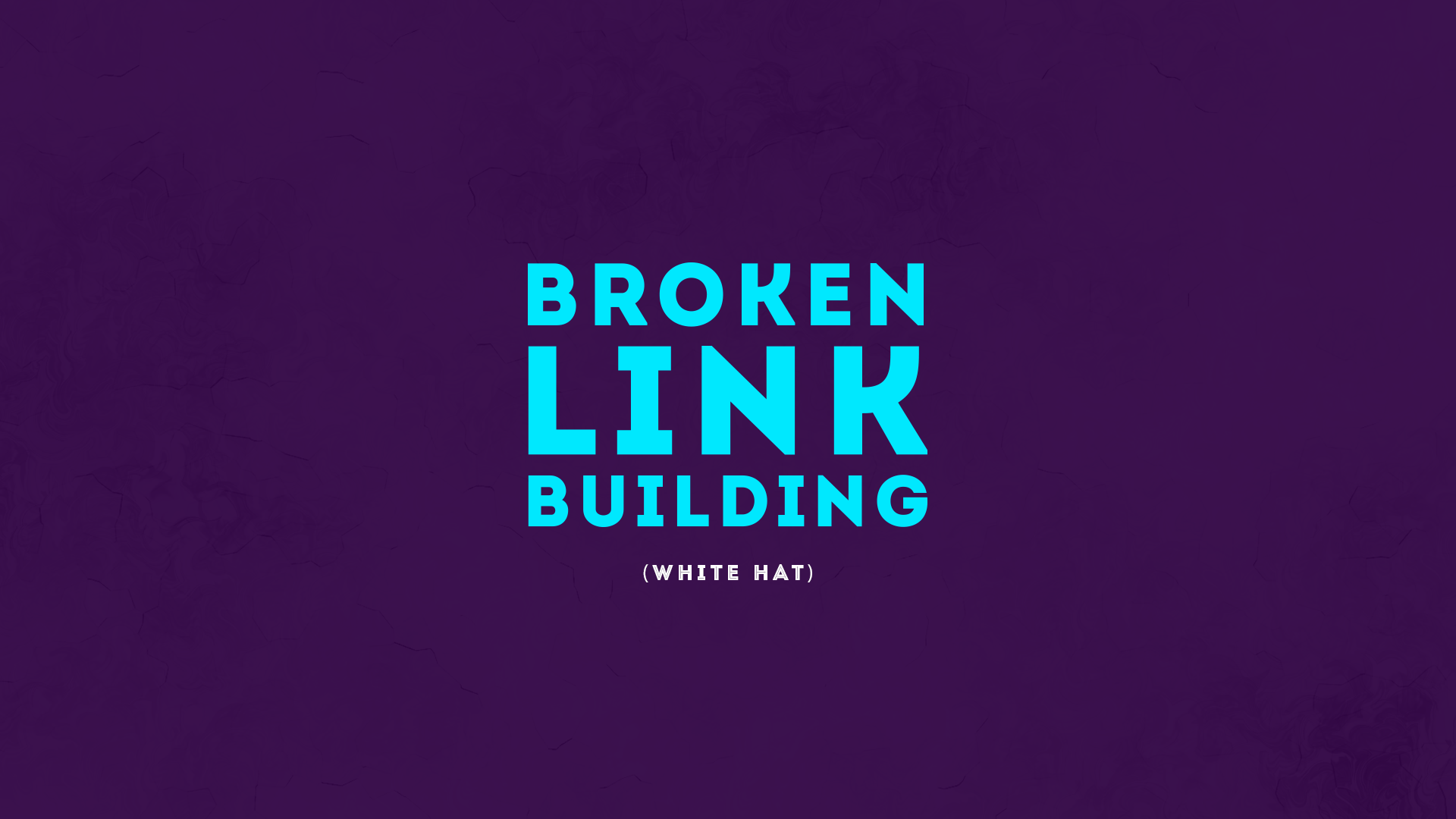
This is a tactic that has already been covered extensively, because it’s one of the few completely white hat methods out there, and as such, the white hat folk in our industry will write til their fingertips bleed in the most detailed way possible of how to execute this method, as showcased in the absolute insane amount of results I found when looking up references for this part of the guide –
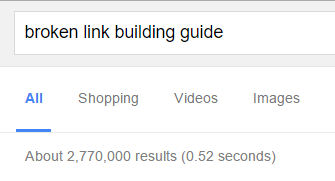
The concept behind broken link building is that you find relevant pages (Normally using Google operators/footprints or exporting lists of links to competitor pages) on websites that have decent authority (Normally gauged by bulk checking pages through Majestic or MozCheck – The latter is a site a lot of you probably didn’t know existed) but have a link on the page that’s “broken”.
Once they’ve found a massive list of sites that have broken (404) links on them, they’ll start either manually or automatically sending out outreach emails about how their link (Normally to a link that uses the Master Content technique) could replace the currently broken link on their site, linking to the page that the broken link is on.
If you can scale this by using VAs to do the work for you, it’s a link goldmine, though doing it yourself will require your new job title to be “Broken Link Builder” as it takes up an incredible amount of time to pull off – Though as I said, I have had a high level of success in securing some very powerful links using VAs to do the work for me.
As much I wish I could spend 10+ hours writing out a proper chapter on how to do broken link building, this post is already ridiculously big and I’m not even half way through yet… So I’ll leave it to the white hat masters who’ve spent an insane amount of time trying to find 404s on relevant pages.
The best guide I have found on this subject so far is Neil Patel’s guide, I say Neil Patel, though it’s likely written by one of his massive slave army of internet marketing interns… No one man can create the amount of content his name puts out.
Note: You can use WikiGrabber to find broken links on Wikipedia, which is a great way to link the Master Content method with broken link building to build trust signals at your website.
Infographic Submissions (Grey/Gray Hat)

A tactic I don’t see many people using what so ever yet it creates an immense amount of branded links and can have very positive effects on your rankings. Myself and James Gregory have been utilizing this tactic for years now and haven’t seen many other sites use it or people speak about it, except those in the IM/SEO industry that have been creating IM/SEO related infographics and gaining a ton of links in the process.
I think the main reason people aren’t using this tactic is because it either takes too much research to create a decent infographic or they think creating one is just too expensive, when in reality you can get very well designed infographics for a few hundred bucks.
There’s several services that I’ve used in the past to create my own infographics, I now just use my designer to create everything but I know a lot of you won’t have your own designer and so here’s a few services you can use to get your infographic created:
- FatJoe’s Infographic Design Service – UK based company, I haven’t used their infographic service in a while, but they have a number of examples and a range of price packages to cater to exactly what you want.
- Envato Studio – From the folks behind ThemeForest and all those other nature based techy download sites, offers up a freelance style site where you can pick and choose from a number of designers with portfolios, reviews and prices.
- Bulldog Infographics – Another UK based company, the same company that created the example I’ve linked to below. Not too expensive and have also got a ton of experience in distributing your infographic as well.
Once you’ve got your infographic made, you’ll need to have a dedicated infographic page on your site (you can see an example here) that’ll act as the place you’ll be building links to.
Once you’ve got your page in place, it’s time to start submitting your infographic like there’s no damn tomorrow!
There’s the obvious ones like visua.ly and slideshare but there’s a good few hundred more when you go looking. Some may be NoFollow, some may be DoFollow but if you can submit your infographics (and the link to the page you built around it) to a number of these sites, you’ll start building out a very solid link profile straight off the bat – Not to mention you can power up any DoFollow links with some of the more black hat methods on this list.
Forum Link Building (Grey/Gray Hat)

Forums have always been a fantastic way to not only get links, but also generate traffic and no, I’m not talking about the spammy forum profile links you’ll see plastered over Fiverr… I mean real forums in your niche that you engage with to build links on as well as generate traffic.
I did this as part of a case study back in 2014 for my old God of SEO blog. I just pulled up the old document and found that most of the links I built are still live today, here’s some examples:
- http://community.adlandpro.com/forums/post/2697036/If-you-build-it-they-will-come.aspx#.VwrwraQrLcd
- http://www.wjunction.com/202-general-discussion-archive/193206-question-about-plagiarism.html#post2016675
Now all of these examples links are signature links, and that is unlikely to work nearly as effectively now. A lot of forums have also created rules around when you can insert links – Sometimes it can take 5 or even 50 posts on a forum before they allow you to post a link, or require some sort of premium upgrade. Several forum software companies (Like XenForo) have also made links (unless you have certain privileges) NoFollow, though as I said in the blog commenting section, that doesn’t mean that the links are completely useless and if you are a fan of Traffic Leaks you’ll know that getting traffic from niche relevant places outside of Google can actually help your rankings – aka, the viral effect.
In 2013 I made a video showcasing how easy it was to find forums to post on, it’s still 100% relevant now:
Once you’ve located your forum, you’re going to want to scope out the kind of community you’re delving into – Each forum normally has it’s own rules, it’s own unwritten rules and a bit of a backstory behind it. The best way to find out the latter 2 is by joining, making an introduction thread (almost all forums have a “New/Introduction” area) and using the persona (or you) that you use on your site or to create backlinks with – Don’t link to your site quite yet though, as you’re going to want to find out what these folks like and dislike, the more they engage with your thread once you’ve created a piece of content for that specific forum, the more traffic you’re going to see from the link you place inside it and at the end of the day, traffic numbers are how a site’s value is estimated, not the backlinks.
You can either choose to do this on a number of forums or become an authority on 2 or 3 and leak traffic off them for the rest of your site’s life. The latter doesn’t help your rankings as much as creating links on a ton of forums, but it does help with bolstering the reputation of your site (because threads about your site come up in your branded SERPs) and gives you traffic from outside of Google, which can be very valuable if anything were to happen to your precious rankings – At this point you should imagine Matt Cutts grinning his beady little face off.
I recently started doing this with the forum Stack That Money, in which I have attempted to become the authority on the site for SEO – There is another user, some of you may know him as ViperChill on there that’s been a moderator since 2014 but he rarely posts aside from having 1 thread stickied on the site.
Most threads in the SEO section have gotten somewhere between 250 – 400 views and a very small number of replies. My threads normally get over 1,000 views and a significantly higher number of replies than most of the other threads on the site. This has resulted in the forum routinely sending me hundreds of visits every month:

Despite popular belief, forums (as long as they’re very niche focused) send traffic that is highly engaged. I often see comments from users referred from my posts on STM and have seen similar stats on my other sites I’ve used these tactics on.
Note: Before posting a thread to a forum, double check that the section of the forum you’re posting to indexes in Google. Pretty simple, just copy the URL of a thread (that was created a few days before) inside one of the Forum sections and search it in Google – If it’s indexed, it’s indexed, if not… Then try a different section of the forum.
Web 2.0s (Black Hat)

Probably one of the oldest methods in the book, and something that has been covered extensively over the last few years, using websites that allow you to create a website under their brand, things like Blogspot and Tumblr to mention a few out of the hundreds of thousands, if not millions currently available.
I personally don’t like using Web 2.0s all that much as I think there are a lot of other links you can build that are more effective for the time/cost investment. The problem with Web 2.0s is that most people use fresh, spammed or syndicated Web 2.0s and they don’t really offer much value for the amount of time or money you invest into them. That said, I have been using a very specific type of Web 2.0 link building to create a pretty powerful way to build links.
If you’re a regular on my blog then you will of probably seen my most recent post on scraping domains & expired web 2.0s, the latter of which is the exact methodology I’ve been using to create extremely cost effective backlink profiles.
Essentially you find Web 2.0 profiles (like the examples I gave above) that people have either changed URLs, let the account expire or deleted their blogs off. You then register that profile as your own and create a site very much like a PBN on it, using that web 2.0 site to link from.
The key in this technique is finding web 2.0s that have good link profiles that can be used as a very juicy link. This negates the uselessness of most web 2.0 backlinks that people create, as it’s not a fresh profile (which is what I was talking about earlier) with no backlinks which holds no real value in Google’s eyes and unless you run them through an indexing service or start building links yourself (which often people hit them with spam using tools like GSA – Which often hurts the quality of the link and doesn’t improve it, despite popular forum belief) will never index in Google and offer literally no value to your site.
Building an expired web 2.0 network is a poor man’s alternative to building a PBN, and is highly suggested if you’re new to SEO as it won’t cost you that $900+ setup to build. Web 2.0s don’t offer as much value as unique, referring domains but they do still hold some weight and if you can build out enough of them then you can rank your site purely with this technique alone.
OnSite Broken Links (White Hat)

Though this isn’t specifically a link building tactic, it’s still extremely important if your site has been around for any amount of time.
You’d be surprised how many links are going to waste on a site, especially those with larger amounts of pages and backlink counts.
Essentially, you want to find any pages on your site that have 404 errors – You can scrape your site with Screaming Frog (premium for more than 500 pages) or Xenu, and export any pages that have 404 errors. Alternatively, go to webmaster tools and export all of your 404s that WMT is seeing, though I prefer using the scrapers as WMT often misses URLs.
Once you’ve collected all your 404s, you’re going to want to head over to Majestic and go to the Bulk Backlinks Tool – Input all your 404s, wait for it to return results, and sort by backlink count:
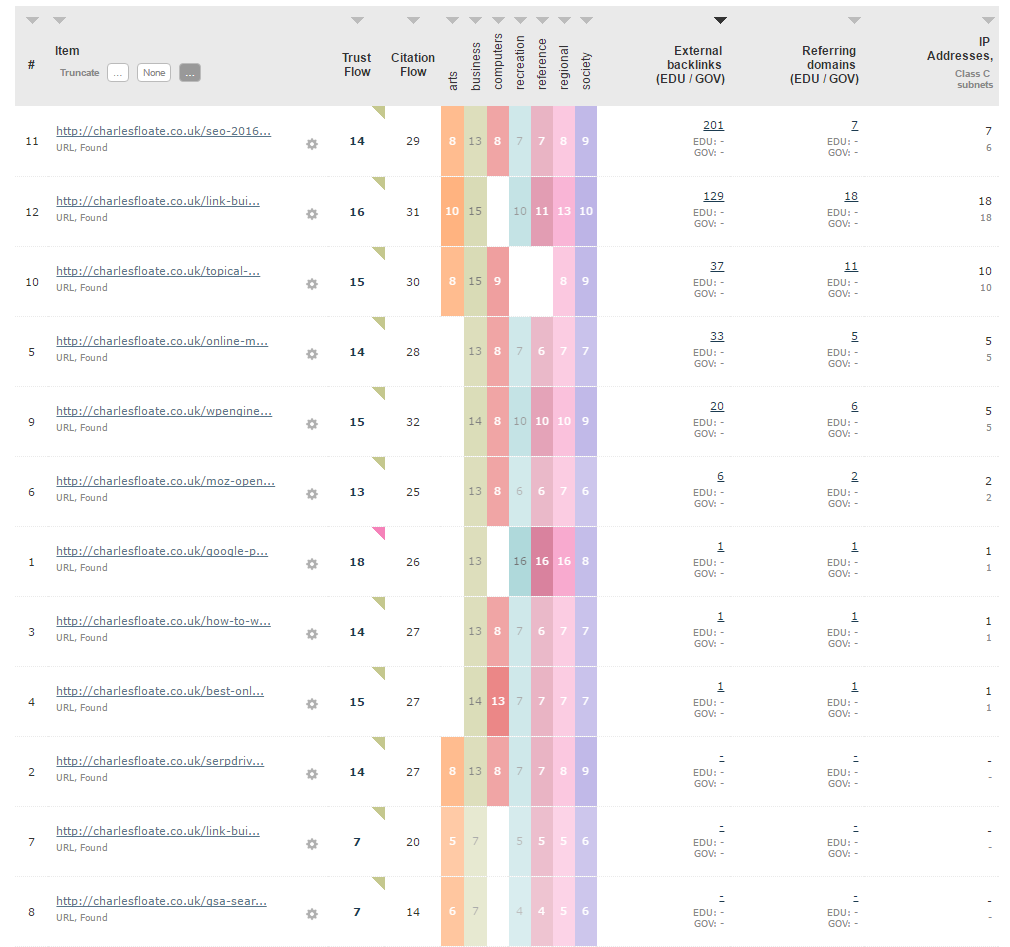
You can then go through each URL, check the link profile/relevancy and 301 these pages to a more relevant page – My site has 0 404s, so I just used some example blog posts instead.
Alternatively, if you have an Ahrefs subscription, you can go to the “Broken Links” tab and use this information to start 301’ing your pages instead.
If you’re using WordPress, just get the “Quick 301 Redirects” plugin. If you’re using a different CMS, then you can just create 301s inside of cPanel, or your htaccess.
301 Redirects (Black Hat)

301s have been used in SEO for a LONG time now, and there is a white hat method of 301’ing broken pages and 404s internally to get back lost link juice… I’ll be covering the black hat version of using 301s either protect a site from potentially harmful links or as a quick-win to increase your authority by 301’ing niche relevant expired & aged domains.
Method #1: 301s For Protection
The age of a domain is taken into consideration when Google looks at how many links it has. It’s likely a site that is 10 years old will have a lot more links than a site that is 10 months old, and because of the way Google treats this, a domain that is very old can be used as a sort of protective barrier in-between the links you use and your money site – This allows you to have a lot higher rates of link velocity (how many links point at your site in an amount of time) and can protect vs some links that would normally trigger warnings within Google’s algorithim and sandbox.
This isn’t necessarily a link building method as such (like method #2 is) but I thought I’d still include it as it’s always good for those that don’t know about these things to learn, and I’ve used 301s to protect money sites for a number of years now.
The way I go about this is picking up an aged domain (Normally from a vendor, or somewhere like NameCheap Marketplace or Flippa where you buy from people rather than dropped domains) host a website on the domain, a default WordPress installation will do and then build my links at the domain – Things like spam, SAPE and cheap PBNs, normally. Once the links have been built and I’ve run them through an indexing service, I 301 the domain at my money site using a .htaccess code from the server that hosted the WordPress installation.
There have been a number of experiments, including my own and we’ve all found that 301’ing a domain from a host is better and more effective than 301’ing a domain from a registrar.
Method #2: 301s For Juice
This tactic involves having a bit of knowledge of the domain industry and being able to understand if a domain is valuable or not, but I’ve had some fantastic results with it and it is normally a lot safer than building links directly to your site. Though make sure you’re building these 301s at a slow pace and registering the domains across a number of weeks/months, as you’ll trigger the algo if you register 5 domains in a day and 301 all of them at your site.
Essentially the method behind this is that you pick-up domains in your niche that already have backlinks pointing at them. You can use auction sites, vendors or setup your own scraping rig to find these domains and then you set them up on different hosts (more recommended, as I talked about in method #1) or at the registrar level, and then 301 them at your site.
This passes the juice (at a reduced rate compared to if the site was it’s own site) of the links pointing at your domain to your money site, in turn giving it a boost in the SERPs.
There are a few notes to be made using this tactic, you want to check the anchor text of your juice domain to make sure the majority of it isn’t exact match for keywords you aren’t going after (branded anchor text is always best) and check to make sure the domain isn’t deindexed / penalized if you’re picking it up from a site like Flippa, you don’t want to spend $100 on a nice, juicy domain to find out it was pointless picking it up in the first place.
As I said before, this method is one of the safest black hat methods you can do and if you spend a good amount of money you can pick-up some really strong domains that’ll give your site a serious boost – I know people who buy entire websites just to 301 them at their site, though that is going into the next league of SEO and requires a serious amount of capital, to ever be worth it.
Local Citations (White Hat)

Citations have become a big business too, there are a ton of services out there that will create local citations for you or your clients at extremely cheap prices, and despite what a lot of people think you don’t only have to use citations for local businesses, they can be an extremely effective link building tool for all sorts of sites.
Generally, citations are used for one of 2 things: Helping get a site higher in the local listings & the map pack, as well as used for pillow links (links that diversify your anchor text and link profile) as the majority of citations will have branded or generic anchor text.
Citations are literally the easiest thing in the world to do, but not a lot of people take the time to build them. I wouldn’t say it’s a necessity when building out an affiliate site or Adsense site. If you’re trying to rank any local site though, you will 100% need to know how to properly build citations. In this part, let me hold your hand as we walk through how to build citations, the easy way.
What are Citations?
Before we dive into the actual link building process – which is really a piece of cake compared to other methods in this guide, I want to talk about what citations actually are, just so you guys understand their purpose. According to Whitespark:
“A citation is any mention of your business out on the web, with or without a link.”
An example: Charles Floate SEO, St Edmunds, 35 Sherwood Gardens, Isle of Gamers, E14 B1Q.
Although this is true, our version/an SEOs version of citations is more local, brand listings in things like directories. Many sites require you to have things like an address, phone number, and website – If you don’t have any of these, then you can always fake it til Google believe that you do have one… Though that quickly turns a very innocent white hat method to more black hat.
Many SEOs are saying that citations make up nearly 25% of the juice you need to put in while ranking a local site, and I don’t believe that they’re wrong. When I start ranking local sites, one of the first things I do is have my VAs build out a few citations to get the ball rolling.
The first thing you need to do to build your citations is get your information together. For your citations to work, you need to make sure that the address on the citation pages matches your Google Local address, if you’re trying to raise the authority of your map packs listing. You need to keep the information the same throughout the entire process. This is why you should copy everything down, and I normally do this inside an Excel doc for each local project.
But Charles, I don’t have a local address for my company…
You’re in luck – I’m going to show you guys how I find local business addresses easily here in the UK and how you can too, even if you’re outside the UK. This method is foolproof, as Google allows you to have multiple businesses under one address.
Step 1
Google something like “offices for rent in London”, and head to one of those massive realty sites. I’m using Right Move for this guide. Go on the site and hit “commercial property”.
Step 2
A huge list of offices pop up. Try to find a small office where you share space with others, but have your own address (like a flat). Here’s an example:
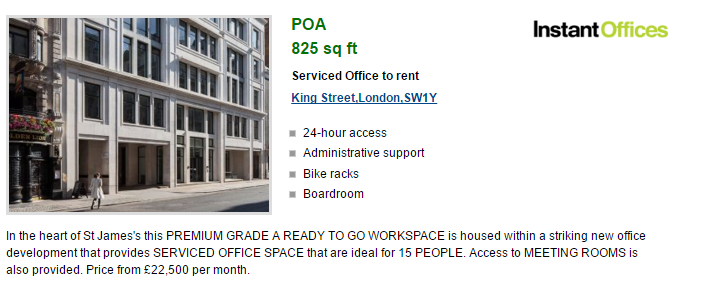
This would work well for our example if we’re doing SEO for a PPL site and don’t actually have a real, physical address. A lot of people choose to use their home address instead of using this method.. but if you’re doing affiliate sites or PPL sites in different areas to your locality, then it’s probably not a good idea to have 50 sites that are supposed to be different businesses/personas under one address…
Step 3
Register the address through Google Local ( and set it up in Google Maps (make sure it isn’t already registered with a quick search). They’re going to send you something that confirms the address, but if you wait a few weeks (I wait 2 weeks to a month), and then call their offices and claim you didn’t receive anything, they’ll always register your address through the phone as long as you’re convincing enough – If you’re a bit scared of this kind of thing, do your research into the perfectly legal social engineering industry.
Note that this is a very blackhat method and for most of you this isn’t needed as this is probably your first time building citations. If you want to pump out PPL sites left and right, this works perfectly though.
Bonus: A lot of you won’t even need to phone them up or ever recieve a postcard, not anymore at least.
If you’re uncomfortable doing this, you can also ask your neighbors to use their addresses. If you don’t have a phone number as well you can just register a number through something online such as Google Voice for a small fee per month.
This is helpful for PPL sites too, as you can redirect the leads or see how many calls are coming in through that number.
Building Citations
Now that we have all of our businesses details in place, it’s time to actually build the citations.
Pro Tip: When filling these out, if I’m doing a lot at once I like to set up RoboForm and let it input the data for me. Fill it in once and you don’t have to go through the tedious copy+paste process while building multiple citations.
Starting the process is simple. Search for something like “business directory London”, and just start submitting your site to every site you can find that doesn’t look shady. MAKE SURE your address and all of your information is correct.
The next thing I suggest doing is using WhiteSpark’s citation finder. You can use it completely free if you like, or if you do a lot of local SEO I’d suggest purchasing it. It makes the process so much easier and you really only spend a few dollars a month on a very good service. They build out citations for you as well if you like, but we can do it quickly manually anyway, and it’s a lot more expensive than hiring and training a VA as well.
As you’ll find, filling out the actual information is very simple. If you didn’t have an address, input the fake one that’s registered with your business and you’ll be good to go.
One last option you could consider is hiring someone on Fiverr to build citations if you wish. I’ll do this for some sites if I just need them done quickly and the quality of the site doesn’t matter as much (for some PPL sites). People on Fiverr can’t really mess this up and citations are already fairly white hat links so 25 won’t ruin your site if they’re done badly. If you want to spend a bit more money, then I’d recommend a service like PBN Butler.
UK Citations List
If you’re UK based, then I’ve compiled a small list of citations I use here.
- http://www.brownbook.net
- http://www.hotfrog.co.uk
- http://www.thomsonlocal.com
- http://www.192.com
- http://www.yelp.co.uk
- http://www.yell.com
- http://www.freeindex.co.uk
- www.citylocal.co.uk
- https://www.uksmallbusinessdirectory.co.uk
If you’re based outside of the UK, then it’s fairly easy to find citations either locally to you (e.g. directories in New York) or nationally via using Google operators, similar to the ones we used in the blog commenting section.
Note: Some directories that you come across will ask you to pay a fee to get listed on them – Don’t do it, it’s normally an “SEO Directory” and will likely give you a DoFollow link from a pretty crappy site. There are some exceptions like Best of the Web and CannyLink and such which we’ve used in the past.
Russian Link Networks (Black Hat)

Yes, I am mainly talking about using SAPE to build links here… but there are several other networks out there, I’ll cover some great alternatives at the end of this segment.
Russian’s don’t really like Google, they use Yandex and the main way businesses in Russia rank their sites in Yandex is by buying links… Almost every website in Russia has some kind of a way to buy a link on it, or is powered in the SERPs by buying links themselves.
This has created an illustrious (almost) underground industry that now caters to not only Russia and Russians, but has opened up an entry-point around the world to get extremely powerful links at very cheap prices. I’ve personally managed to secure PageRank 5+ links for as little as 30 cents a month. That is pretty much unmatched in comparison to the rest of the world, though these links are not contextual and Google does routinely go after SAPE and various other networks. It is pretty much impossible for Google to take out the whole of SAPE however, as of writing this it currently has over 675,000 different sites you can get links on, which translates to over 681 million unique pages.
Some SAPE Alternatives:
- SEOPult
- LinksManagement (US-based, semi-expensive)
- SERPZilla
- MainLink
Even though all of these sites have a fantastic inventory size, none of them really compare to the size and cost of SAPE.
Sponsored Link Building (Grey/Gray Hat)

This is by far one of my favourite link building tactics in the current SEO landscape. They’re highly effective, often very affordable and (if done well) almost impossible for Google to ever tell they’re unnaturally built.
- You start off by setting up an email outside of your own brand – I suggest using one away from your brand, incase you come across a white hat warrior that starts trying to expose you or report you to Google for attempting to buy links.
- Then gather a list of blogs you want to gain a link from, and start gathering contact information – I suggest using PitchBox, as it tends to be the fastest tool on the market.
- You then want to carefully craft an email template out to approach these various bloggers with offers to purchase links on their blog.
As an example of a template I have used:
Hey there,
I’ve been reading a few of your posts, and they’re really good – Your blog is really in depth, and it just so happens to be in the same industry as us.
We know it can be really difficult to make any sort of a living as a blogger, and we’d be willing to help out your cause and provide some financial support if you could in return provide a guest post on your blog for us?
We aren’t asking you to build links to a spammy site or product page, just a site that’s in the same industry as yours, to a blog post we’ve invested 10s of hours creating.
Thanks
Charles
This email alone, had about a 40% response rate and we were getting TF10 – TF60 links for between $20 and $100. At that price, it’s often cheaper (and a lot safer) to carry out this process instead of using PBN links.
Make sure you do proper research on the blogs you want to pay for, and it’s always a good idea to create a database of sites that accept paid guest posts, in case you want to come back at a later date for another site – My database is now over 8,000 sites. Bigger than most PBNs out there.
Non-Branded Guest Blogging
Another type of this type of link building, is “Non-Branded Guest Blogging” – You use a persona (or personas) outside of your own brand to do a guest blogging campaign, in which you link to various pieces of your own content and get a “non-branded mention” in return – I’ve seen some MASSIVE companies carrying out this exact process, and it’s extremely effective and very safe.
This is also a great way to create your own influencers in an industry – If you can have non-branded influencers, that have their own following.. It can become a massive asset at a later date to manipulate your industries media, get reviews on new products/launches from recognizable people in your industry and even use them for things like retargeting, competitions and list building.
Imagine if YOU were every influencer in your own industry.
Link Reclamation (White Hat)
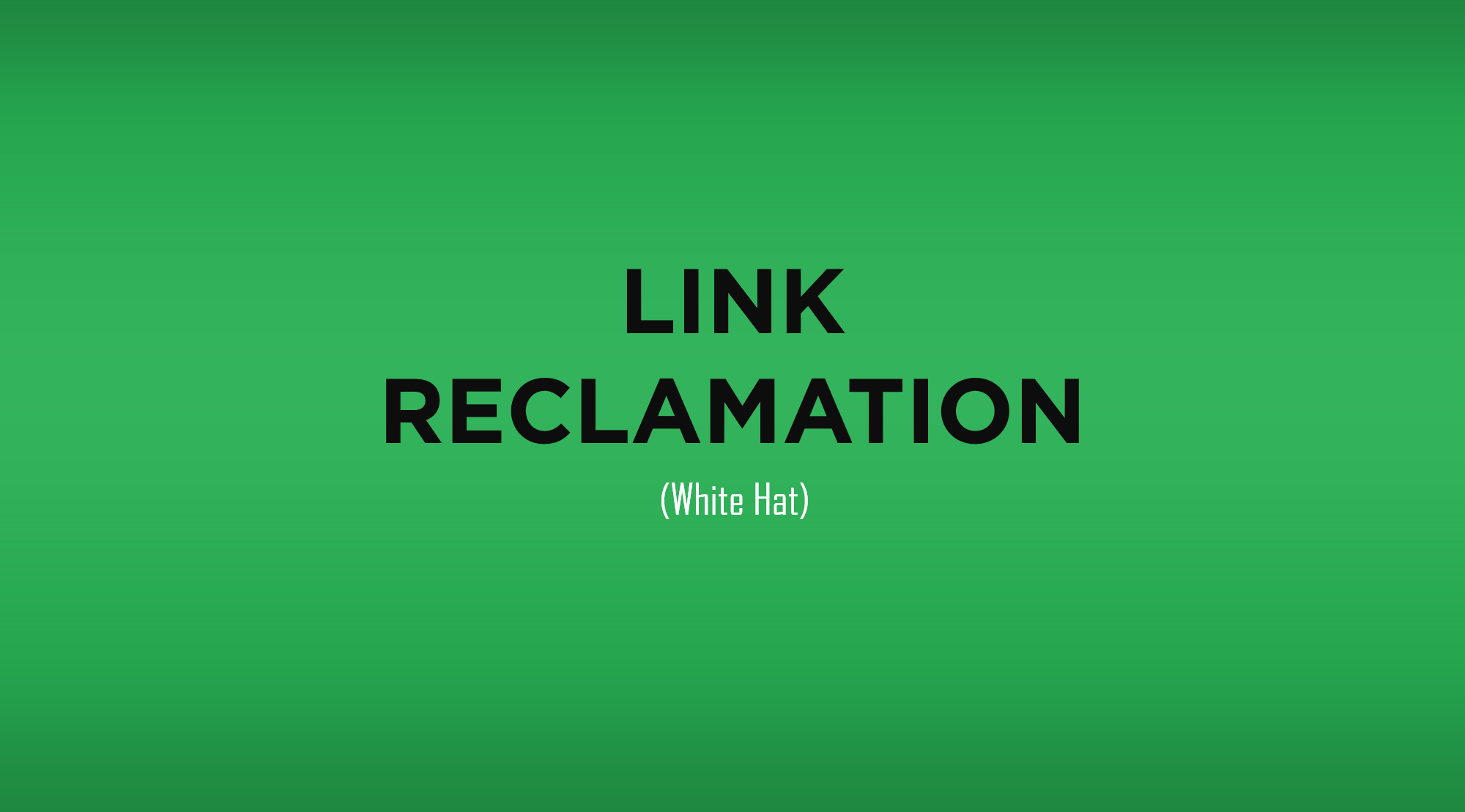
I covered this tactic in a lot more extensive detail in my link building eBook, but I thought I’d cover it here as well.
A vast majority of the time, people will mention your brand (or use your image/video etc) without linking to you.
You can find people who’ve mentioned your branded but not linked to you by using the Google footprint:
BRAND NAME HERE -site:yoursite.com
This will find any mentions of your brand name, excluding your site. It may take you several hours to find a lot of these brand mentions and outreach to the sites to get the link back.. but it only costs time, and is fantastic for bigger brands/sites.
As I said, you can also do this for images, videos etc.. Which I covered in my eBook.
Note: You can also use the tool “Mention” to setup automatic alerts for search and social media of brand mentions. This makes this type of link building a LOT easier – Ahrefs also has a similar tool in their arsenal.
Other Link Building Tactics
I know a lot of people have questions surroding various other link building techniques, so I thought I’d add an extra section to cover these link building techniques and my thoughts on them.
Press Releases
I have actually already covered this topic in one of my videos:
I do not recommend using press release distribution services at all, especially in the Penguin 4.0 landscape.. Instead, do press releases 1 by 1 and allow them to be syndicated by those niche relevant sites you submitted the PR to.
Content Syndication / IFTTT SEO
I do think content syndication has it’s place, but most of the modern IFTTT SEO people are doing simply doesn’t work, I covered this in a video I put out:
You can actually use re-posting type PBNs or Web 2.0 networks to syndicate your own blog content, and in turn pass link juice to your new blog pages straight away. Though I’d prefer just doing unique articles and submitting them, rather than syndicating the same content, as Google tends to weaken the link value if you use duplicate content across your site.
Q&A Sites (Yahoo Answers, Quaora etc)
I actually really like this type of link building, and it’s become a rather natural way to go about building links.
Simply use a Google footprint, such as:
site:answers.yahoo.com “keyword here”
And go through the questions, trying to find ones without answers or ones you can answer yourself.
You may ask why I use a Google footprint, instead of the sites search bar.. Well, it tends to be a better link if it’s ranked higher in the G search engine, than the sites internal one.
Directories
You may be wondering why the hell I’ve put a tactic that is from 2004 on here, but there’s still some serious weight to be had from the web’s most trusted directories.
With the news of Dmoz (the world’s most respected directory) shutting down, the title of the internet’s new top dog directory likely goes to Best of the Web, though they do charge a nice $300 fee to get permanently listed – After you apply of course.
There are a handful of other worthwhile directories to get links from on the net, here’s a few examples:
- Joe Ant
- Umdum
- Go Guides
- 01 Web Directory
- UK Small Business Directory – If you’re based in the UK, of course.
Most of these directories charge you a small fee to submit your site for review but as long as you keep it clean, you’ll likely get accepted or the majority refund your money anyway.
Competitor Link Building
This tactic involves knowing all of the other tactics, and/or having access to a backlink checker such as Ahrefs or Majestic to export your competitiors backlinks.
You can also tie this kind of link building into the “master content” link tactic I showed towards the top of this page.
Using Majestic or Ahrefs, find the top performing pages (in terms of links/shares etc) and start creating an even bigger piece of content.. Then systematically outreach to every site your competitor got a link from and request a link. This may take several follow-up emails, and hours to create the piece of content but most companies won’t of created anything more than >2k words.
You can also use the software RankCracker (by Matthew Woodward) –
This will allow you to find links from your competitors that can be replicated by software or outreach – I often find TONS of Web 2.0s, Forum Profiles, Directories etc.. Using this piece of software.
Note: RankCracker was released over 2 years ago now, and this tutorial is 2+ years old.. I’m not sure on how updated it is of now.
Scholarship Link Building
All the rage in the past few months, it seems every affiliate site I look at has got some form of scholarship program now-a-days – Though it does make sense, as most will offer an English lit style scholarship which is awarded to the student who produces the best piece of content.. A $1,000 for a bunch of English students to write your content all day long is a pretty cheap price to pay, and getting some links from .edu sites thrown in makes it even better.
The process is fairly simple:
- You create a scholarship page on your site offering a cash scholarship to the winning entry – Normally $1,000.
- You outreach to every university that has a scholarship link page and ask them to submit it around there student base too.
- You get entires, evaluate, pick a winner and boom.. You’re on the scholarship directory pages of some of the most prestigious universities in the world.
It’s a fairly straight forward concept, just requires a financial investment upfront.
Link Building Tools
I don’t really use too many SEO tools out there, and I did cover a lot more link building tools here.
I will cover the tools I use on a regular basis here though.
Ahrefs – Link Checker, Traffic Checker & Keyword Research
Ahrefs has quickly become one of the best (if not the best) SEO tool suite on the marketplace.
I use it on a daily basis to check their HUGE database of links, look at sites that are ranking in Google (generally competitive research) and their keyword research tool has become very good too.
If you’re a content marketer/white hat, then looking at their content explorer can be extremely helpful, and is a great alternative to BuzzSumo – Which is another fantastic tool.
Majestic – Link Checker
Though the index size isn’t as big (from my own comparisons) as Ahrefs, I highly prefer going by the Majestic metrics and their topical link mapping is fantastic as well.
It’s always good to have even more data, and if you’re wanting to look at link profiles, then I’d suggest picking up both.
Excel – Data Sorting
Every link building needs to have, and understand Excel.
Whether you’re using xPath to scrape data, or just using a sheet to sort through your link profiles or sponsored guest posting contacts.. It’s a must have for any link builder.
PitchBox – Outreach
Hands down, the best outreach tool on the market. We use it at my agency for every outreach task we ever do, and it is significantly better than any other outreach tool on the market. Pricing isn’t too bad either.
PB also comes highly recommended by both Gareth Simpson & Ryan Stewart – 2 of the best outreach link builders on earth.
Link Building For A Brand New Site
I previously had this part as it’s own post, but thought it’d be better suited being merged into this post, and covers a topic a lot of people get very confused about.
What You Need To Know
There are certain things you’re going to need to know before beginning your link building campaign, so I thought I’d formulate a mini FAQ for you to answer them before we get into the tactics themselves.
Is there a time and place for different kinds of links?
Well while that’s probably going to be up for debate, I don’t think there’s any question that on a new site you’re not going to want to start building links at a frequency of dozens per day.
These days I prefer to take a little bit more of a white hat approach with my sites, especially during the first 3-6 months.
The first links I’ll typically build are for my social profiles, this makes sense for 2 reasons.
- These links are common in any link profile.
- You want to secure these profiles early to prevent any profile grabbing.
Once there’s a good amount of content on the site, say anywhere from 5-10 articles, not including all the money pages you’re building out then you’re in a good position to start the REAL link building work.
Where should I be building these links to?
Well typically during early link building I find it much wiser to build links to your homepage, and that’s because a site without traffic isn’t going to be getting a great deal of links to inner pages.
Another good reason for doing this is building up authority to the homepage at the very beginning – Pre-existing authority means any new pages you build on your site will automatically gain rank.
Building links to your homepage also means you can balance out your anchor text profile early, which again puts you in a good position for later. As I said earlier in this post, you need to be thinking a few steps ahead!
What anchor text should I use?
Following on from what I just said, you want to balance out your anchor text profile early…
For me I like to build the majority of my early links with the following types of anchor:
- Branded (yoursitename)
- Naked (yoursite.com)
- Raw (http://www.yoursite.com/)
- Generic (Visit site etc)
Getting these done early with those easily acquired links is a great way to go about your early link building because you’re not jumping the gun.
In the past I’ve had prospective clients come to me who have started out building links for themselves, one of the biggest mistakes I’ve seen in cases like these is that a client had gone out and built links from directories, profiles and the like using exact match and partial match anchor text.
Why this was a problem: This was a problem for my client as they had unbalanced their anchor text profile, when it came to getting the links that had some real power they had to first have twice the amount of links built to just rebalance their link profile.
So it’s safe to say, it’s better to use those easy to acquire links with anchor text that’s going to give you the ability to use the right kind of anchor text on the more powerful, less easy to acquire links later!
How many links should I be building?
There’s no right or wrong answer here, but one thing that is in my mind a clear fact is that you need to scale your link building over time.
If in the first week all you did was build links from your social profiles that would be a good thing in my view, if on the second week you built up to 10 links then that’s alright too.
If you know in advance how many links your competitors have, and how many you think you’ll need to surpass them in the SERPs then you can work out a good frequency for your link building campaign.
Are you planning to flip the site in 6 months? Is it a long term project that you foresee taking you at least a year? Your own definition of early link building is going to differ depending on the length of the project, total.
Knowing this is really important, because the slower you are with your early link building the safer you’re going to be, but at the same time you need to know that you’ve done all that you can do within the early stages to get it ranking as highly as possible.
Just to help you understand this concept a bit better I’ll give an example:
If your four main competitors have an average of 500 links and their sites have been established for 2 years, then you’d need to build 24 links a month to match them in 2 years.
However, if you want to match them in six months then you’d need to build 83 links per month.
In the early stages however that’s way too high, so you’re going to want to halve that at a minimum. So in this scenario, a 6 month project you’d say that the first month is that ‘early’ stage and you’d want to build roughly 41 links that month. Then the following 5 months you’d need to make up the other 42 links.
Of course ranking isn’t as simple as just matching your competitors link volume, but it’s something that’s useful to be thinking about, especially if you’re trying to establish how many links to build initially. We’re all fond of saying ever SERP is different, so it can pay to use a flexible, SERP relative approach.
Another idea I’ve used in-practice before is using a tool like Ahrefs to find out how many links my competitors gain per month on average and then use that as my link volume for early link building, so long as it isn’t ridiculously low!
Note: Anchor Text, Volume & Frequency
You should know that the links your building in your early project will affect the amount of links you need to build later.
If you build 100 links that are evenly split between branded, generic, raw and naked URL you’re going to have to do a little bit of math to figure out how many links you’re going to need to build that are exact match, partial match etc.
It’s an easy mistake to make by overlooking this, but to keep your anchor text profile healthy you need to think about it. The more of these links you build, the more links you’ll need to build in future to effect the percentages and balance of your link profile’s anchor text distribution.
Trust Signals
I’ve talked about this before on my blog, and it’s something you can do before hand to allow you to create more links initially.
Before Google looks at a link profile, it’s algorithm works out how “trusted” your website is, it has an “authentication” layer that looks for signals to see if your site is real or not.
Some trust signal examples would be:
- Domain Expiration Date (How long until your domain expires)
- Domain Age (How old is your domain)
- SSL Certificate (Google prefers secure sites)
- Real Whois Info (There has been previous correlation between ranking without whois privacy and with it, the latter being worse)
- Social Signals
- Social Profiles
And a whole heap more as well.
If you can get all of these trust signals in place early on, before your site is even live.. Then it can help allow a higher link velocity (more backlinks being built) than without them.
Planning Your Link Targets
One thing that I have always found useful in any project is planning out my links in advance, while I don’t do this for the entire project I always do it for the early link building.
The first thing I do is identify high value links, these are the links that either have high DA, relevance or potential traffic as well.
You can use tools like ScrapeBox to scrape hundreds of relevant blogs for dropping comment links, or you can simply use Ahrefs to dive into your competitors link profile for potential link targets.
Aside from these basic tasks, you can get creative and try to look for new link opportunities elsewhere.
You can also look at those high DA sites such as BuzzFeed for scoring a decent link (whether it’s NoFollow or not). A lot of these user submitted content sites have high DA and will only cost you the price of a cheap, well written article or a few minutes to register an account.
Sites such as BuzzFeed, BoredPanda, Reddit and Imgur all also have one thing in common, and that’s that they have large audiences, so these are links that can send you traffic quickly. Does Google care whether people are clicking your links? It’s a topic up for debate, but it’s certainly not going to do any harm!
The best way to plan out your link targets is to simply use an Excel spreadsheet and document the URL where you can build the link, what it’s going to cost, the type of the link, the DA of the site and leave room for any notes such as what anchor text you’re planning to use.
There’s no need to get carried away, but you need to keep track of these links, even after you’ve built them. You may even need to expand the spreadsheet to include usernames, passwords, emails and whether the link was submitted successfully or not.
The takeaway point here with early link building is ‘fail to prepare, prepare to fail’.
So let’s get into some actual ‘tactics’ for where you can look to get links in these early stages of your new websites conception.
Tactic: Content Sites
Content Sites such as BuzzFeed, BoredPanda etc are great sites to score some links from because of their high authority within Google – Don’t get authority and domain authority by Moz mixed up, they’re 2 very different things, and I personally do not believe in using metrics as an accurate way to gauge the quality of a link.
Treating your site during early link building as though it’s an upcoming authority site on it’s topic is no bad move, and scoring a few links from these kinds of sites is just going to signal that to search engines.
Other sites that you could potentially call content sites, are sites such as Imgur and the like, a lot of these sites may only offer NoFollow links to deter pesky spammers, but there’s a definite benefit to going for these links regardless… A healthy link profile is going to be made up of a mix of Do and NoFollow links after all.
Tactic: Social Media
Using social media sites to quickly get links is one of the first things you should, and probably do actually do for your new projects.
However a lot of people stop after creating profiles for just a few of sites, which isn’t really maximizing opportunities for links…
While you may not have plans to use many social media sites actively, it makes sense to have your brand on as many as possible, not only for the links but to prevent any brand jacking and to just ‘be everywhere’ – If you build up branded search traffic, it’s good to control the first page with your pages.
While this would normally take you a lot of time, there is a great service called KnowEm which will set you up on more or less all the social media sites out there. It’s not free, but if you’re not doing seo on a budget then you may as well use this to grab all your profiles quickly.
Another thing you should be doing with social media is automating your content being posted out as it’s published, you can use IFTTT to create a bunch of recipes so that when your new post is published you’ll immediately share the URL to each social media site you’ve set it up for – Just make sure it doesn’t syndicate the entire post, or you could harm your site.
This gives you the benefit of getting some ‘social signals’ from the off, and that early bit of traction may be enough to get a whole host of people visiting your site and sharing your content. There’s absolutely no reason for you to not be doing this, but there’s definitely a lot of sites out there I’ve seen that still aren’t!
I also highly suggest using social platforms like Reddit & Tumblr to both generate traffic and links, though Reddit pages will quickly be indexed and give you a solid NoFollow link (DoFollow if it hits the front page of a subreddit) Tumblr can be a lot slower, so you may not see much effect on rankings for several weeks or months after building Tumblr links. Running all of these links through an indexing service can’t hurt.
Tactic: Press Releases
There’s always a lot of confusion about whether press releases are good, and what exactly it is that they are.
Press releases are fantastic for new sites, where you’re looking to get a little bit of publicity and some early awareness / traffic to your site. Of course, this means you’re going to get links as well.
However, not all press releases are done the way they should be…
When you write a press release you’re basically creating a narrative about your brand that a potential journalist may want to pick up and syndicate or write about. If you have an interesting story, you’re going to make it more likely that you’ll get a boat load more links.
This is why whenever I run a competition on one of my sites I send out a press release to get the ball rolling.
Finding a good angle for your press release is definitely an important part of getting the most out of this tactic for link building, but you should also pay attention to where you’re getting your press release distributed.
Of course there are free services like PRLog which is better than nothing, but the best press release services are going to be paid ones and I’m not talking about a press release distribution service like PRWhirlwhind.. Those are likely going to distribute press releases to 70 random, non-niche relevant sites that’ll end up spamming your backlink profile with duplicate content and potentially harmful links.
I kind of already covered this in a video I made a few weeks back –
Essentially, you want to do indiviual press releases to niche specific sites or niche categories of sites, e.g. the Business & Economics section of Journalism.co.uk – Which you can drop a paid press release on, for not too expensive amounts.
Tactic: Blog Commenting
One of the most old school link building tactics is of course blog commenting, there’s almost an endless supply of blogs out there that you can comment on, with 2 million new posts published every day.
Using a tool like Scrapebox (Go to Scrapebox.com/BHW for a $30 discount) you can quickly use the common footprints to find hundreds of blogs, which is exactly what I do.
When it comes to doing the blog commenting, if you want to do this in a white hat manner, you need to actually write out thoughtful, helpful or interesting comments. This of course means reading the article, or at least skim reading it a couple of times.
While this undoubtedly takes you a lot longer, the benefit is that your comment is more likely to get accepted and published, meaning that those links are going to stick.
You can also expect some traffic to your site if this is a new post, or if you’re getting one of the first comments in there.
Generally if there’s over 20-30 comments I don’t bother as for me that’s too many OBL’s to be worth the effort, but sometimes I do make an exception to that rule if the blog is a competitors site with poor moderation or a site that’s got a high level of relevancy to my own.
Looking for blog comment opportunities from relevant sites is absolutely crucial these days, these links don’t offer a lot of power and are mostly a good way to build out your anchor text profile and referring IP diversity, but if you can get some extra relevant links it may just move the needle a little!
Another good idea is using an RSS Aggregator such as Feedly to monitor active blogs in your own niche, or within your broader audience to see when a new post is published and to get your comment in there first.
This can send hundreds of visitors your way, as well as give you a good link from an active site if you do the comment right and get it through moderation. This month so far, comments have already sent me over 60 visits.
All in all, blog commenting is alive and well, but as with all link building you need to go that extra mile and put in the hard work to get the results.
Tactic: Infographic Submissions
This tactic has been popular for a few years now, not only because there’s a huge number of infographic submission sites out there, but because creating a good infographic is always worth your time.
Infographics are great linkable assets, and you can even implement an embed code directly underneath your infographic on your site to encourage other webmasters to add it to their site with the appropriate credit.
When I’m launching a new site I try to make it a priority to create at least one infographic to add into one of my pieces of content and it’ll usually help you pick up some links.
I also don’t think it hurts when doing outreach, because not only can you offer other webmasters the infographic to add to their site (worth checking if they feature them regularly), but it shows them that you care about your site and that you’re the kind of site they want to be linking out to.
Some submission sites will require payment, some may just require registration and whether you get a NoFollow or DoFollow link will vary, but it’s a good tactic to use regardless.
Here’s a few places you can submit your infographics to:
- http://www.reddit.com/r/infographics
- http://www.nerdgraph.com
- http://submitinfographics.com
- http://infographicsite.com
Trust me, there are HUNDREDS of sites out there, which makes it the perfect pillow linking strategy.
Tactic: Forums
Yes, even forums can be worth getting a link from these days! However I like to do it with a twist and here’s what I’ll recommend you do…
First of all qualify the relevant forums, then you want to make sure that the forum is active and not spammed to holy hell. All good? Ok.
Find out if there are any sticky resource threads, then find some content to replicate using the skyscraper technique.
Once you’ve done this you’re going to engage with the forum, just a few posts a day for a week or two, call it 10 days.
Then you’re going to PM one of the moderators of the forum to suggest adding ‘this post’ (your post) instead – Even if they don’t feature it, you still have a nice forum thread (which generally rank VERY well in Google) with a link back to your site that offers value to both Google, the Forum (for further authority in your niche) and your site: As you’ll likely get traffic from the post.
You can even incorporate broken link building methods into this tactic.
Note: Some forums allow you to input your “Homepage” into your profile, which will then show on every post you make on the forum – This is a great alternative to finding clever ways to insert links.
Tactic: Link Section / Blogroll Outreach
This has to be one of the oldest outreach methods out there, namely because not a lot of sites have link sections or resource sections these days.
There is an upside though, and that’s that there’s still a lot of old websites out there that do, and getting your site link on there is an absolute must. Depending on your niche you can find hundreds of blogs and sites to reach out to for this.
One of the most popular implementations of this strategy is broken link building, but you can also incentivize the webmaster by offering them a small bribe if the link is really worth it…
You can find these kinds of opportunities by scraping for common footprints, but you’ll likely also find a lot of sites linking out to your competitors from these pages. If you can, then your ultimate win is going to be getting your link added and your competitors link removed. So be creative, be smart and don’t be spammy.
It really does pay to hand craft these outreach emails for each individual site, just find something you can comment on, whether it’s an old blog post (to give them a long-term reader vibe) or how you really like X about the site.
Since a lot of these sites are inactive, your success rate might not be too great, but it’s no excuse not to grind out outreaching to as many of these sites as you can.
If you’re really not going to do these by hand and don’t have a VA or staff member at your disposal, then you can check out a tool called GMass which is free and allows you to use gmail to send out mass template based e-mails to a list of contacts where you can add variables such as name, email and so on to really personalize the message (as much as you can with automation).
Note: If you’re in a popular niche, you can often find sites that’ll allow you to post a link to a page for a small donation, aka donation link building.
Tactic: Influencer Outreach
One of the best things you can possibly do for your new site is make connections with influencers in your niche or broader niche.
Not only do influencers command large audiences, but usually they have very powerful blogs in terms of link value.
You can make a list of influencers early on and start connecting with them on Twitter or wherever it is that they hang out, get yourself on their radar, all the while traversing their site looking for potential avenues to get a link.
Do they have a link section? Do they regularly link out to supporting content in their own blog posts? If so can you use the skyscraper technique to provide something better for them to link out to?
There’s almost endless possibilities here, but it all starts with making a list of the influencers early on and getting on their radar.
Using a spreadsheet you should make a list of the influencers by name, social media URL, website, e-mail and anything else that you think is important to keep track of them.
After a week or so, and interacting fairly regularly (maybe even commenting on their blog as well) you can get in touch with them via e-mail because you should have figured out your angle by now.
Here’s a template I put together and use for the skyscraper technique after doing the above things first:
Hi Name,
I’m a relatively new reader of your site. However I absolutely LOVE your content, especially (insert post here) which
(insert something complimentary here to let them know you are a reader).
You may have seen me on (social media site) or my comment on (insert post name) as I’ve been getting involved more recently.
I actually run my own site (about x) here’s the (link)
I noticed that in your (insert post here) that you link out to (insert url here)
I actually have a very similar post which I think your audience might find more useful…
(List reasons why)
Here’s the post: (link)
It would be a huge compliment if you read the post and let me know whether you think it’s worth
linking to or just gave me some feedback in general.
Looking forward to seeing your next post!
Sincerely,
Name
I get a fairly good success rate with this template, but the template isn’t what’s important… You have to offer value of some kind to the influencer first, and let them realize that you’re not just some random webmaster looking to get a link out of them.
By showing them that you’re a reader who is getting involved, they’ll understand that you are a valued member of their audience and they will most likely want to reciprocate that, provided your piece of content is actually better!
You should aim to keep on-going relationships with these influencers, keep getting involved on social media and they’ll most likely share your content when you post it out.
Drop them an e-mail from time to time as well, there’s no formula for success here, but it’s just communicating with another human being when it comes down to it, and everyone has an ego that can be stroked. If you want more than that, I suggest you read ‘How to win friends and influence people’ which is a great book for this exact kind of thing.
Tactic: Directories
Directories are still a useful place to get links for your site, it’s just that there’s a lot of bad directories out there…
Buying a directory package from Fiverr is unlikely to be the kind of ‘white hat’ friendly sites that you’re looking for, so it’s going to pay for you to do some research, maybe a bit of scraping and a lot of patience to find some good niche relevant directories.
There are other directories you can look at though that are a lot safer, although they may cost you some money.
Dmoz is one of the most coveted directories on the web and you can suggest a site to be featured here, it’s not going to necessarily result in a definite listing, but you should give it a go anyway. Best of the Web also charges a $150 annual or $300 one time fee to put your site in their directory, which can be worthwhile if there’s not much competition.
The crucial thing is avoiding the low quality link farm directories that are so common, so use your best judgement, but it’s not worth writing them off until you look into each of them properly.
Expanding Traffic
Once you’ve got some basic links for your new site, there’s still some additional things you can do that are going to help you expand your traffic and your sites organic visibility in general.
Additional Keywords & Competitor Research
One of the biggest things that you can do to increase your sites visibility in Google is to look for additional keywords.
These keywords can help you improve your search presence a lot, by either adding them to existing pieces of content or crafting new pieces of content to target them specifically.
One thing I like to do for new sites is focus on search impressions (viewable in webmaster tools) rather than just organic visits. I know that if I can get my site from 100 to 10,000 impressions on Google without even ranking on page 1 for the majority of my keywords that by the time I am on page 1 that 10,000 impressions will soon turn into 50,000 or more.
So how exactly do you go about finding additional keywords?
There’s a few ways…
Webmaster Tools
If you go into webmaster tools > search traffic > search analytics, you will be able to see a number of keywords you’re ranking for that you may not even be aware of.
These keywords can vary from no search volume to huge amounts of searches, and yes a lot of these keywords are going to be long-tails.
Using a Google Chrome Addon called Keywords Everywhere you can actually pull up the search volume for keywords in Analytics, Webmaster Tools and on the SERPs themselves!
Using this new data you can quickly figure out what keywords are worth looking into more, making a list of them is a fairly good idea at this point as you’ll want to keep track.
Your next job is to find out what URL is ranking for those keywords, because you can either go into that piece of content and expand it or if you’re worried about diluting the rankings of that piece of content for other keywords then you can create a whole new piece of content for that keyword and link from the currently ranking piece of content > the new piece of content.
This works well because Google already associates the piece of content that’s linking to the new piece as being about the target keyword, so you’re basically telling Google that this new piece of content is more relevant to the keyword.
This little trick more often than not results in leapfrogging your old position and it’s a good way to start expanding traffic.
Competitor Research
Another way to start searching out new keywords is to look at your competitors rankings, and the best way to do this is either with Ahrefs or SEMRush.
The kind of data you’re going to get back is going to be incredibly useful, as you’ll find keywords they’re ranking for that you may not have picked up during your initial keyword research.
This is much like the keywords you’ll find when looking through your webmaster tools accounts data.
Sniping your competitors keywords is an important tactic for getting more traffic and ultimately beginning to dominate the competition.
You can download the data, or make a physical set of notes about the keywords you’ve found and either make a giant monster of a post that targets multiple keywords or create one piece of content for each keyword.
I recommend the former. That brings us to our next point which is content expansion.
Content Expansion
One great way to expand traffic is to focus on keyword impressions, so once your site has the power to rank on the first page, your organic visits will explode.
Once you have new keywords, you can find existing pieces of content on your site and keep improving those pieces of content. A hundred words here, a thousand words there… It doesn’t really matter.
The point is that I’ve seen my longer pieces of content, that I’ve updated regularly, keep on popping up for new keywords and improving in the rankings for existing keywords.
List posts are doing especially well, where each new list item is a keyword, and the content beneath the list item title is supporting that keyword with LSI terms, long-tails and synonyms.
I think that for a new site, to keep improving your traffic you should be aiming to update at least one post per week and really grow these pieces of content into cornerstone pieces for your site.
They can link out to the smaller posts on your site and become great linkable assets, adding in things like infographics, videos or even slideshows, these posts will be extremely useful when it comes to outreach and gaining links further propelling them up the SERPs.
Should there be any limit to how much you expand content? I’m not totally sure because I haven’t pushed those limits yet, but there is a fine line most likely.
One thing is for sure though and that’s that
I’d rather have ten 5,000 word posts than fifty 500 word posts.
Site Auditing
While I should probably do an entire series on site auditing, it’s worth mentioning that this is an important aspect of expanding and improving your traffic.
It’s another thing that’s often overlooked, but unless you’re positive that you’ve done everything right from the start it’s worth looking into…
There’s also the fact that as your site expands, you’re going to have broken links pop up, you’re going to forget to keep all your internal linking up to date.
For this what I use is a fantastic free tool called MetaForensics.io which checks just about everything you could want it to and more.
The absolute basics of a good audit though are going to be checking your heading tags, your image tags, your metas and the like. So get used to doing those from the beginning otherwise you’ll need to audit your site regularly and put in a lot more work than you need to correcting the problems.
Some Extra Thoughts on Link Building
Actually building links is just half the battle, there are a few other things I thought I’d write about for you guys and gals to take into consideration when executing a link building campaign.
ROI-Focused Campaigns
A lot of people who are members of my course will know that my mentality when it comes to SEO is all about ROI. If it costs you 10 hours / $1,000 to rank in a competitive niche that has a maximum payback of $50/week, then it’s obviously not worth it. It is genuinelly very hard to gauge the risk vs reward of ranking in a SERP, but it becomes easier the more familiar you get with ranking sites and the conversions of specific niches, products and what you end up getting paid for those conversions.
I always refer to having that “SEO Jedi Sense” that you gain over the {weeks|months|years} of working in SEO, but if you use logic and a bit of maths… You’ll be able to see if a keyword/niche is worth going into or not.
Here’s an example:
A product on Amazon goes for $100, the average payout I get for amazon referrals is 0.07% aka $7 for this particular product. The monthly searches for the niche that this product is in, and the product itself is a little over 5,000 – Not a really high amount, but not that bad either.
If we manage to rank top 3 for all of the keywords inside this niche, we’ll likely be getting a unique visitor count of between 1,500 and 2,500 and if we convert at a 0.05% conversion rate, then we’ll be getting about 100 sales per month – That’s $700 per month.
Now, if we had Amazon, eBay, Wikipedia etc… All on the first page, it’d likely not be worth going after that kind of a product/niche, as it’d require a significant upfront investment to go after it – However, if you can find a number of longtail keywords that don’t feature any of those authority sites, it’d be a good idea to go after those first, and use the income from the site to go after the bigger ones at a later stage.
However, if the keywords straight off the bat feature various other affiliate sites with low amounts of content, or poorly written content and small numbers of backlinks… Then it’d be an obvious niche/product to go after.
This is a very broad example and there are multiple other factors to look at when analyzing weather a niche is good to go into vs the competitors you’ll be facing, a few more examples would be:
- Competitor Domain Age
- Social Signals
- Ranking Page Age
- Links to the Ranking Page & to the Root Domain
There are a ton of overall factors you need to take into consideration and it’d take me an entirely different blog post (of similar length) to show & explain to you what they are. Though all of these points are a fantastic start.
Anchor Text
One of the most heavily debated topics in SEO, and something that continually plagues the industry every year… Is what anchor text ratios should people be using.
Anchor text is simply the text used within a link from one website to another.
Instead of repeating myself and adding an additional 500 words to this already very large post, I’ll just insert a video I made at the start of the year on this topic, as I think it explains my thoughts on it very well –
Remember that as Google runs updates and the more the algo progresses, anchor text ratios change throughout – It started easing up recently, and it’s likely going to go back down again soon.
The most optimal anchor text ratio (from all the research we’ve done over the last year) is 13% exact, 10% – 20% partial and the rest branded, generic or persona based. This recommendation should survive any penguin update in the coming years, as long as the links you’re building would survive the update as well.
Surrounding Text
The text that goes around your link can also contribute to you ranking for additional keywords and be a factor in terms of the authority/relevancy of your link.
Google will look at the surrounding text (if the link is contextual, if not, it’ll look at the surrounding page) and evaluate what kind of keywords the link is relevant to – This means any text around your anchor text, can also count towards being a keyword. It’ll also increase your “topical relevancy” of the link, and help you in the topical circles that Google creates around specifics sites/links/industries/pages.
NoFollow Links Are Still Worthwhile
Despite what a LOT of people have said in the past, NoFollow links are still worthwhile to build.
Not only do they balance out your anchor profile, but Google also counts them towards “trusting” your website – For example, getting a NoFollow link from Wikipedia or the BBC, though it won’t give you any significant boost for a keyword in the SERPs.. It will still add “trust” to your website, so you can have more links pointed at your site, as your site as seen as more trustworthy by Google.
However, large amounts of comment links (aka 500+ in a matter of weeks) is highly unnatural, and you still want to be careful around how you go about building these kinds of links, as they can still have a negative impact on your site.
Rolling Penguin vs Link Building
Now that Penguin 4.0 has come out, and we’ve seen most of the aftermath of it so far. We can make an accurate assumption about how rolling penguin will affect the future of link building.
So far, we’ve seen:
- Contextual links win, and non-contextual links lose.
- Link velocity play more of a factor into links.
- Higher levels of exact & partial match anchor text (>25%) getting hit.
Check out the full post I linked above for more of my thoughts on this.
The Disavow Tool
A lot of people have asked me for my thoughts on the disavow tool, and I haven’t really covered them before.
If you have been hit with negative SEO, previously built spammy links and got hit or just got pretty piss poor links on the site.. Then I’d suggest using the disavow tool.
HOWEVER, if you have not seen any negative impact from links that YOU have built, then I highly recommend NOT using this tool – It’s just a red flag reason for Google to start looking into your site, especially if it’s already ranking.
Be A One Man Link Building Machine
Despite what a lot of people say (generally those with vetted interests in selling links) it doesn’t require a ton of cash to build a ton of links, in fact.. You can theoretically do a very solid link building campaign without any paid tools, services or people. I know, because I’ve pulled them off myself.
I’ve given some great examples above, as well as throughout my blog in which you can build links for totally free – From blog commenting to building links on Wikipedia, if you have a new site or are new to SEO, then I recommend using my ROI-Focused mentality and doing as many things yourself as humanly/timely possible. Not only will it give you invaluable insight and experience, but you’ll be making a lot more money as well, as time costs you (almost) nothing.
Note: If you are doing local SEO, then check out my guide here on how I helped a friend of my family rank for a solid local term with $0 spend.
Thanks For Reading
I hope you enjoyed this massive post, it took me an entire weekend to write, and I was up til 5am on Sunday finishing this bad boy off… If you’d like to learn more cool SEO tips and tricks for the modern SEO world, then join my email newsletter below for a free 7 day SEO course, and don’t forget to comment with your favorite link building methods as well.
- Charles

